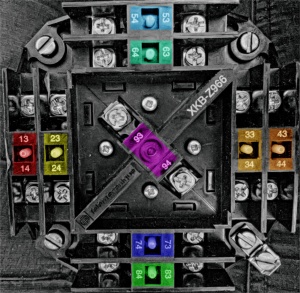Archive:WiFiJoystick: Difference between revisions
Jump to navigation
Jump to search
add IO expander section |
→mqtt topics (receive): extend examples |
||
| Line 172: | Line 172: | ||
|- | |- | ||
| WiFiJoystick/<CHIP-ID>/color/led1 | | WiFiJoystick/<CHIP-ID>/color/led1 | ||
| | | solid/once/flash/fade,red,green,blue(,interval,red2,green2,blue2) | ||
| solid,255,0,0 | | <p>solid,255,0,0 <br/>(solid red)</p><p>once,0,255,255,5000 <br/>(pink for 5s)</p> | ||
|- | |- | ||
| WiFiJoystick/<CHIP-ID>/color/led2 | | WiFiJoystick/<CHIP-ID>/color/led2 | ||
| | | solid/once/flash/fade,red,green,blue(,interval,red2,green2,blue2) | ||
| fade,255,0,0,2000,0,255,0 | | <p>fade,255,0,0,2000,0,255,0 <br/>(fade from red to green in 2s)</p><p>flash,0,0,255,500 <br/>(flash from blue to black every 500ms)</p><p>flash,255,0,0,1000,255,255,0 <br/>(flash from red to yellow every 1s)</p> | ||
|} | |} | ||
= I2C IO expander = | = I2C IO expander = | ||
Revision as of 11:29, 29 June 2016
| WiFiJoystick Release status: experimental [box doku] | |
|---|---|
| Description | WiFi connected Joystick and Gamepad |
| Author(s) | Jorgen |
This page shows a short description of how to create a WiFi enabled Gamepad / Joystick. The WiFiJoysticks can be used to play games on LED-Panels on events like makerfaires.

joystick & buttons
pin mapping
| function | state 1 | state 2 | state 3 |
|---|---|---|---|
| Push Button | 
|
||
| left | 
|

|

|
| right | 
|

|

|
| up | 
|

|

|
| down | 
|

|

|
mqtt topics (receive)
| topic | payload | example |
|---|---|---|
| WiFiJoystick/<CHIP-ID>/config | flags to configure | reboot |
| WiFiJoystick/<CHIP-ID>/brightness | brightness from 0 to 255 | 190 |
| WiFiJoystick/<CHIP-ID>/debounce/push | debounce delay in ms | 200 |
| WiFiJoystick/<CHIP-ID>/debounce/button1 | debounce delay in ms | 200 |
| WiFiJoystick/<CHIP-ID>/debounce/button2 | debounce delay in ms | 200 |
| WiFiJoystick/<CHIP-ID>/debounce/left | state1,state2,state3 (debounce delay in ms) | 150,100,200 |
| WiFiJoystick/<CHIP-ID>/debounce/right | state1,state2,state3 (debounce delay in ms) | 150,100,200 |
| WiFiJoystick/<CHIP-ID>/debounce/up | state1,state2,state3 (debounce delay in ms) | 150,100,200 |
| WiFiJoystick/<CHIP-ID>/debounce/down | state1,state2,state3 (debounce delay in ms) | 150,100,200 |
mqtt messages (sending)
| topic | payload | example |
|---|---|---|
| WiFiJoystick/<CHIP-ID>/button/push | press or release | press |
| WiFiJoystick/<CHIP-ID>/button/button1 | press or release | press |
| WiFiJoystick/<CHIP-ID>/button/button2 | press or release | press |
| WiFiJoystick/<CHIP-ID>/button/left1 | press or release | press |
| WiFiJoystick/<CHIP-ID>/button/left2 | press or release | press |
| WiFiJoystick/<CHIP-ID>/button/left3 | press or release | press |
| WiFiJoystick/<CHIP-ID>/button/right1 | press or release | press |
| WiFiJoystick/<CHIP-ID>/button/right2 | press or release | press |
| WiFiJoystick/<CHIP-ID>/button/right3 | press or release | press |
| WiFiJoystick/<CHIP-ID>/button/up1 | press or release | press |
| WiFiJoystick/<CHIP-ID>/button/up2 | press or release | press |
| WiFiJoystick/<CHIP-ID>/button/up3 | press or release | press |
| WiFiJoystick/<CHIP-ID>/button/down1 | press or release | press |
| WiFiJoystick/<CHIP-ID>/button/down2 | press or release | press |
| WiFiJoystick/<CHIP-ID>/button/down3 | press or release | press |
status LEDs
mqtt topics (receive)
| topic | payload | example |
|---|---|---|
| WiFiJoystick/<CHIP-ID>/color/led1 | solid/once/flash/fade,red,green,blue(,interval,red2,green2,blue2) | solid,255,0,0 once,0,255,255,5000 |
| WiFiJoystick/<CHIP-ID>/color/led2 | solid/once/flash/fade,red,green,blue(,interval,red2,green2,blue2) | fade,255,0,0,2000,0,255,0 flash,0,0,255,500 flash,255,0,0,1000,255,255,0 |
I2C IO expander
The ESP8266 has too less IO pins - so we will use IO expander ICs with serial interface (I²C-Bus):
